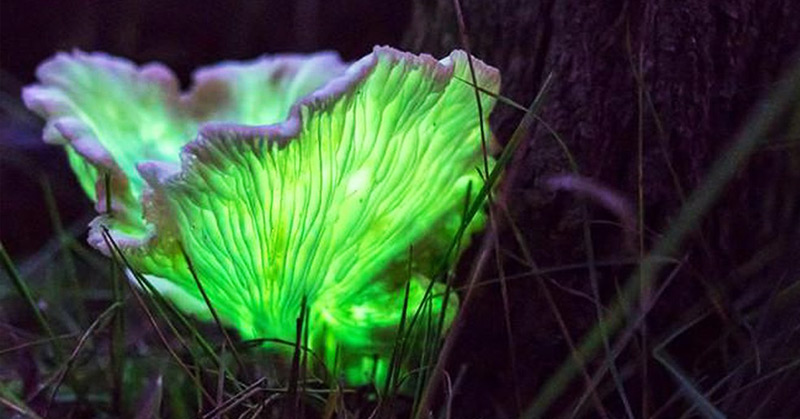Standing in the middle of a forest at midnight in the pitch dark, surrounded by glowing mushrooms may sound like something out of J.R.R. Tolkien’s fantasy world in Lord of the Rings, but in New South Wales, Australia, the ghost mushroom makes this a very real scenario.
Following a cold and wet Autumn, national parks and forests all across the region come alive with an array of various fungi. They’ve become a veritable wonderland for foragers, hikers, and nature photographers.
The hardiest of photographers are setting out to these areas at night, in hopes of capturing one very special fungi on camera known colloquially as the ghost mushroom.
The Ghost Mushroom
This bioluminescent fungi’s real name is Omphalotus nidiformis, and is in southwest Western Australia, all down the east coast, and in Tasmania. You will often find them in wooded areas, along streets, and in parks.
According to biologist Julie Fielder, they glow 24 hours per day while they are fruiting, during the main fungi season from autumn to winter. Of course, you can only see them glowing in the dark. They are typically found growing at the base of eucalyptus trees, banksias, and casuarinas and are both parasitic, meaning they feed off live tree tissues, and saprotrophic, meaning they eat dead things, such as rotting wood [1].
What is Bioluminescence?
Ghost mushrooms have been given their name because of their bioluminescent properties, but what exactly does that mean?
Bioluminescence is light produced in a living organism caused by a chemical reaction. The light it produces is referred to as “cold” because less than twenty percent of the light emits thermal radiation or heat. The majority of bioluminescent organisms are found in the ocean, such as jellyfish or bacteria.
In order for a creature to bioluminesce, or glow, they must have the chemicals luciferin, as well as luciferase or photoprotein. Luciferin produces light, and depending on the arrangement of its molecules, the color that is produced will be different. Some organisms will produce luciferin on their own, while others absorb it through other organisms.
Luciferase is an enzyme that interacts with luciferin to produce light. In some cases, however, photoproteins are combined with luciferin and oxygen, and with the help of a catalyst like a calcium ion, produces light.
Organisms use bioluminescence for a number of possible reasons. Some glow to confuse attackers, or to actually camouflage themselves through a technique called counterillumination. Others use them to attract or search for prey, or to attract a mate [2].
Read: Dolphins appear to glow as they glide through bioluminescent waves
Why do the Ghost Mushrooms Glow?
Scientists are still unsure as to why the ghost mushroom glows. One theory that is true for other species of glowing fungi is that it is used to attract insects, which then disperse the mushroom’s spores and help it to spread [3].
Researchers in Adelaide, however, determined that this was not the case for Australia’s ghost mushroom. They believe instead that the luminescence produced by the fungi may just be incidental- that the chemicals that produce the light may provide some other benefit to the fungus and the glowing green color is just a byproduct [4].
Read: Diver Captures Rare Footage Of A Sea Angel Swimming Under The Ice
How to find a Ghost Mushroom
First of all, you have to go to Australia, since ghost mushrooms are found primarily in Victoria, Tasmania, the eastern coast, and the southern parts of Western and South Australia. According to Carol Probets, a birding and nature guide from the Blue Mountains in New South Wales, it is best to first learn to recognize them in the day, so that you will be better able to find them at night.
“If you learn to recognise it in the daytime, it’s much easier to find it in the daytime rather than wandering around in the dark,” she says [4].
When you are looking for them, you should not expect to find them glowing bright green the way they do in photos. To the naked eye, the light appears as a much dimmer blueish-white. Photographers who are trying to capture the beauty of these mushrooms typically use a tripod and a camera that is capable of taking long-exposure photos. This makes the glowing hue appear much brighter and greener [4].
If you do decide to go searching for the magical ghost mushrooms, it is important to understand, however, that ghost mushrooms are poisonous and so should not be eaten.
Keep Reading: Everything you need to know about the glowing Sea Turtle
- https://www.abc.net.au/news/2017-05-31/ghost-mushroom-hunters-photograph-glowing-poisonous-fungi/8573560
- https://www.nationalgeographic.org/encyclopedia/bioluminescence/
- https://www.ncbi.nlm.nih.gov/pmc/articles/PMC5159592/
- https://www.theguardian.com/environment/2017/apr/15/hunting-the-ghost-fungus-glowing-mushrooms-in-australias-forests

